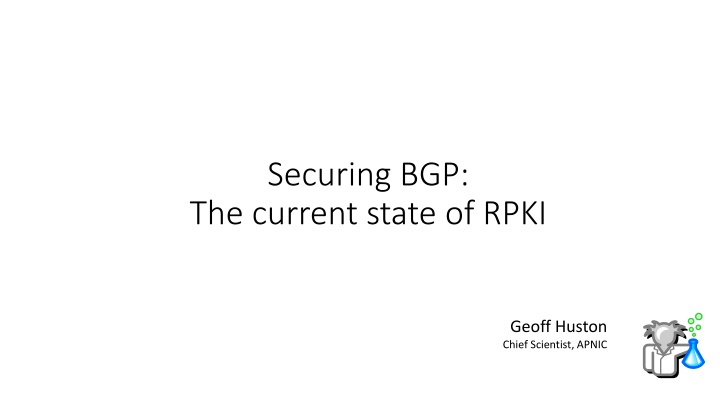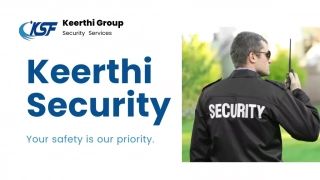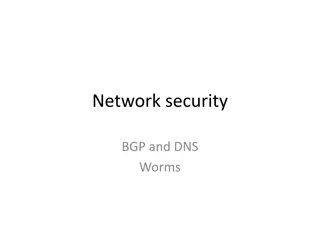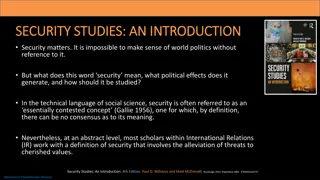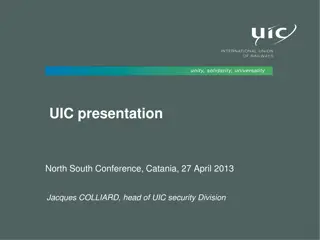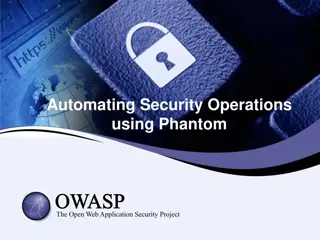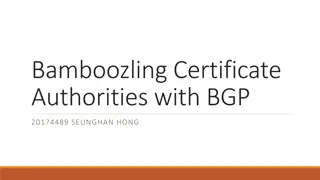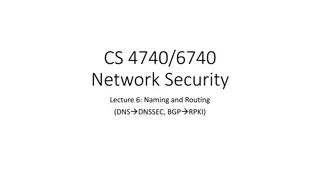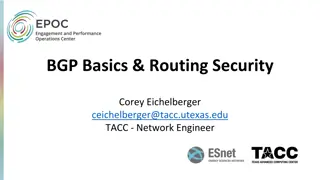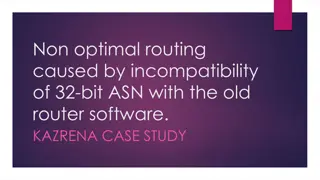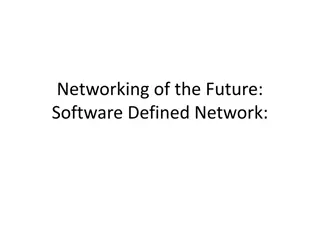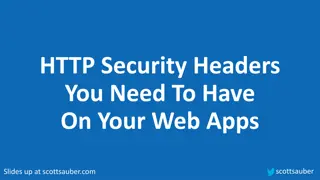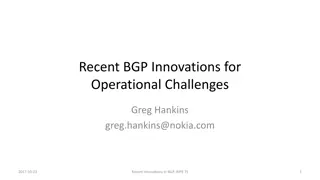Ensuring BGP Security State
The current state of RPKI in BGP security, potential threats including traffic interception, malicious activities with route announcements, and the need for proactive measures in the digital landscape.
Download Presentation

Please find below an Image/Link to download the presentation.
The content on the website is provided AS IS for your information and personal use only. It may not be sold, licensed, or shared on other websites without obtaining consent from the author.If you encounter any issues during the download, it is possible that the publisher has removed the file from their server.
You are allowed to download the files provided on this website for personal or commercial use, subject to the condition that they are used lawfully. All files are the property of their respective owners.
The content on the website is provided AS IS for your information and personal use only. It may not be sold, licensed, or shared on other websites without obtaining consent from the author.
E N D
Presentation Transcript
Securing BGP: The current state of RPKI Geoff Huston Chief Scientist, APNIC
What happens when I announce your addresses in BGP? All the traffic that used to go to you will now come to me I can disrupt your service I can inspect unencrypted traffic that was heading towards you I can send out traffic as if it was you I can emit spam, mount bot attacks, or misbehave I can get a certificate in your name I can inspect encrypted traffic heading to your servers I can mount pernicious man-in-the-middle attacks
If I were evil I d announce your routes Use an automated cert issuer to get a certificate issued for your domain name Attract all secure traffic intended for your service and pass it on (man-in-the-middle) But I use _MY_ encryption to the end user, so I can see everything the end users does with your service, including their passwords And its not clear that they will notice anything amiss
If I were evil I d announce your routes Use an automated cert issuer to get a certificate issued for your domain name Attract all secure traffic intended for your service and pass it on (man-in-the-middle) But I use _MY_ encryption to the end user, so I can see everything the end users does with your service, including their passwords And its not clear that they will notice anything amiss
If I were evil I d announce your routes Use an automated cert issuer to get a certificate issued for your domain name Attract all secure traffic intended for your service and pass it on (man-in-the-middle) But I use _MY_ encryption to the end user, so I can see everything the end users does with your service, including their passwords And its not clear that they will notice anything amiss
What do we do today? I ask you to route my net: You look the net up on whois If it all seems to match then accept the request and add it to the network filters for this customer
What do we do today? I ask you to route my net: You look the net up on whois If it all seems to match then accept the request and add it to the network filters for this customer
What do we do today? I ask you to route my net You ask for me to provide a Letter of Authority Which is an effort to absolve you of all liability that may arise from announcing this route You then add the to the network filters for this customer
What do we do today? I ask you to route my net You ask for me to provide a Letter of Authority Which is an effort to absolve you of all liability that may arise from announcing this route You then add the to the network filters for this customer
What do we do today? I ask you to route my net You ask for me to provide a Letter of Authority Which is an effort to absolve you of all liability that may arise from announcing this route You then add the to the network filters for this customer
What do we do today? I ask you to route my net You ask for me to enter the details in a route registry Access filters may be automatically generated from route registry data
What do we do today? I ask you to route my net You ask for me to enter the details in a route registry Access filters may be automatically generated from route registry data
What do we do today? I ask you to route my net You ask for me to enter the details in a route registry Access filters may be automatically generated from route registry data
What do we do today? I ask you to route my net You ask for me to enter the details in a route registry Access filters may be automatically generated from route registry data A publicly accessible description of every import and export policy to every transit, peer, and customer, is difficult to maintain, and is not in the best business interests of many ISPs
Whats the problem here? Whois lookups typically require manual processing. This information is also somewhat informal so it often requires some level of interpretation and judgment Whois lookups are an admission process, not a means to maintain route filters Letters of Authority are just a way to try and avoid liabilities they are not a useful tool to manage routing Routing Registries come in all shapes and sizes! Which is itself a problem there is no single authoritative source The expression of routing policies quickly becomes complex and error prone Is this a case of attempting to harness too much information?
The RPKI Approach None of these approaches are very satisfactory as a complete solution to this problem Let s take a step back and see if we can use digital signature technology to assist here. If we can, then we can construct automated systems that will recognise validly signed attestations about addresses and their use
Using Cryptography to tell Good from Bad This looks a lot like an application of public/private key cryptography, with authority to use conveyed by a digital signature Using a private key to sign the authority, and the public key to validate the authority If the private key was held by the address holder then we have the notion of binding the control over an address to holding the private key We can use a conventional certificate infrastructure to support public key validation at the scale of the Internet But how can we inject trustable authority into this framework?
Trustable Credentials How can we inject trustable authority into this framework?
Trustable Credentials How can we inject trustable authority into this framework? Bind the Registry and the key structure together: Use the existing address allocation hierarchy IANA, RIRs, NIRs & LIRs, End holders Describe this address allocation structure using digital certificates The certificates do not introduce additional data they are a representation of registry information in a particular digital format
Resource Certificates A resource certificate is a digital document that binds together an IP address block with the IP address holder s public key, signed by the certification authority s private key The certificate set can be used to validate that the holder of a particular private key is held by the current legitimate holder of a particular number resource or not! Community driven approach Collaboration between the RIRs since 2006 Based on open IETF standards Based on work undertaken in the Public Key Infrastructure (PKIX) and Secure Inter-Domain Routing (SIDR) Working Groups of the IETF
The RPKI Certificate Service Enhancement to the RIR Registry Offers verifiable proof of the number holdings described in the RIR registry Resource Certification is an opt-in service Number Holders choose to request a certificate Derived from registration data
What Can we Sign? One approach is to look at the process of permissions that add an advertised address prefix to the routing system: The address holder is authorising a network to originate a route advertisement into the routing system The ROA is a digitally signed version of this authority. It contains An address prefix (and range of allowed prefix sixes An originating address This allows others to check the validity of a BGP route announcement: If there is a valid ROA, and the origin AS matches the AS in the ROA, and the prefix length is within the bounds of the ROA, then the announcement has been entered into the routing system with the appropriate permissions
So ROAs can help An automated solution that checks the validity of a route announcement against a local repository of digital certificates: Which can be used to feed a BGP routing filter that can isolate certain instances of what looks like attempted route hijack
Are we using RPKI and ROAS Two questions: What proportion of existing route advertisements have associated published ROAs? What proportion of network operators will reject a route if the associated ROA set indicates an invalid route advertisement (possible route hijack)
ROA publication https://rpki-monitor.antd.nist.gov
ROA publication https://rpki-monitor.antd.nist.gov
ROA publication https://rpki-monitor.antd.nist.gov
ROA Use https://ripe74.ripe.net/presentations/43-ovs-study-ripe74-plen-final.pdf
ROA Use https://ripe74.ripe.net/presentations/43-ovs-study-ripe74-plen-final.pdf
Errrr If route hijacking is such a problem then why aren t we all publishing ROAs and running ROA filters on our routers? Cryptography and Certificate management operationally challenging which is often seen as one more thing to go wrong! Without everybody running BGPsec that it is not a very robust defence As long as a hijacker includes your ROA-described originating AS in the faked AS PATH the hijacker can still inject a false route If ROAs are challenging for operators, then BGPsec is far more so!
The Perfect can be the enemy of the Good Maybe there are some Good things we can do right now instead of just waiting for BGPsec to work!
More Ideas? Waiting for everyone to adopt a complex and challenging technology solution is probably not going to happen anytime soon Are that other things we can do that leverage the RPKI in ways that improve upon existing measures? Use ROAs to digitally sign a LOA? Digitally sign whois entries? Digitally sign Routing Policy descriptions in IRRs Signed data could help a user to determine if the information is current and genuine This would not directly impact routing infrastructure, but instead would improve the operators route admission process to automatically identify routing requests that do not match signed registry / routing database information
